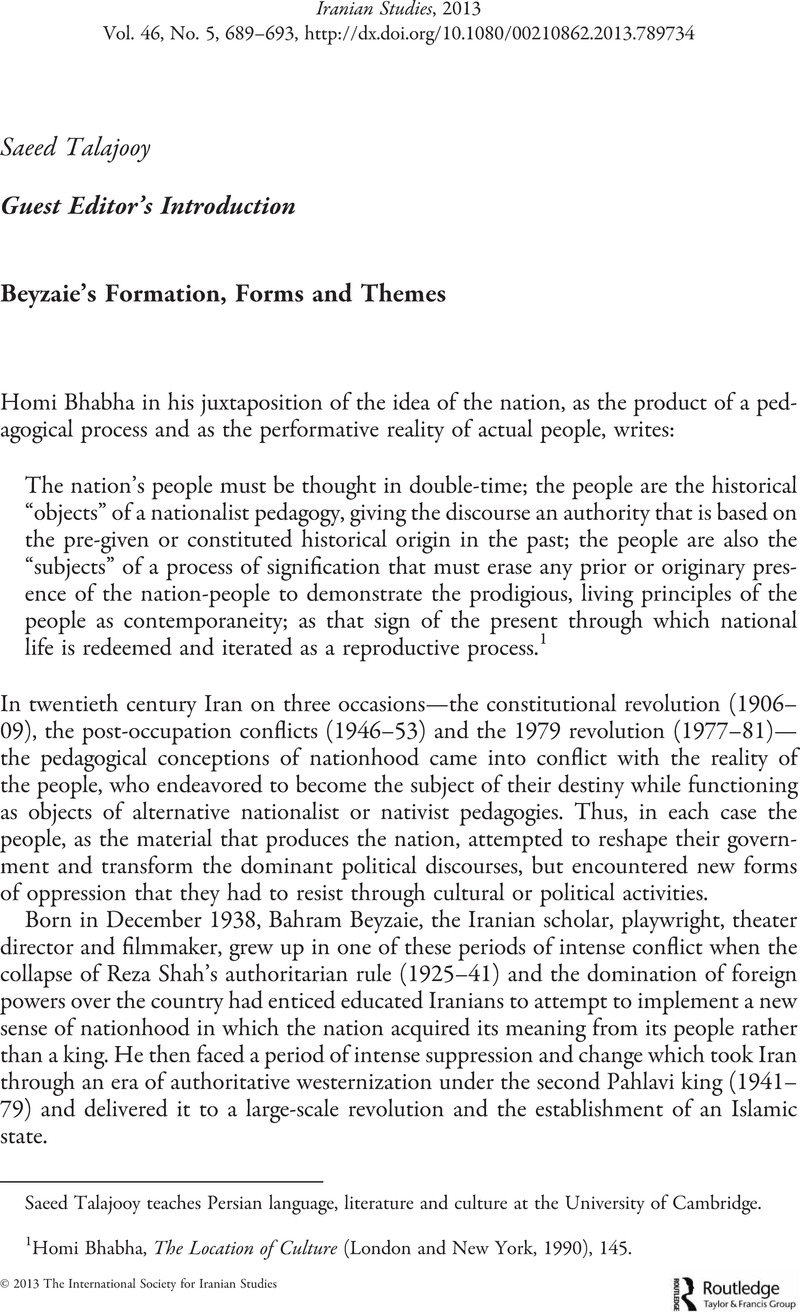No CrossRef data available.
Article contents
Guest Editor's Introduction: Beyzaie's Formation, Forms and Themes
Published online by Cambridge University Press: 01 January 2022
Abstract

- Type
- Introduction
- Information
- Iranian Studies , Volume 46 , Issue 5: Special Issue: Bahram Beyzaie's Cinema and Theater , September 2013 , pp. 689 - 693
- Copyright
- Copyright © The International Society for Iranian Studies 2013
References
1 Bhabha, Homi, The Location of Culture (London and New York, 1990), 145.Google Scholar
2 For a more detailed examination of this quality in Beyzaie's work and echoes, in Persian, of the discussion here, see Talajooy, Saeed, “Shahr, Khaneh va Khanevadeh: Revayat-e Tajaddod dar Kalagh va Shayad Vaqti Digar-e Bahram Beyzaie,” Iran-Nameh 27, no. 1 (Spring 2012): 142–61.Google Scholar For more on “epistemic privilege, see Bar On, Bat-Ami, “Marginality and Epistemic Privilege,” in Feminist Epistemologies, ed. Alcoff, Linda and Potter, Elizabeth (London, 1993), 83–100.Google Scholar
3 For ta'ziyeh and other Iranian performing traditions, see Beyzaie, Bahram, Namayesh dar Iran (Tehran, 1365).Google Scholar For brief descriptions of the major forms, see Talajooy, Saeed, “Indigenous Performing Traditions in Post-Revolutionary Iranian Theatre,” Iranian Studies 44, no. 4 (July 2011), 497–519.CrossRefGoogle Scholar
4 Bahram Beyzaie, “Interview,” Cinema (September 1977), quoted in Parham, Baqer, “Kudak, Zan, Gharibeh va Taqdir-e Tarikhi,” in Majmueh Maqalat dar Naqd va Moa'refi-e Asar-e Bahram Beyzaie, ed. Ghukasian, Zaven (Tehran, 1999), 27.Google Scholar
5 Bahram Beyzaee, “Interview with National TV” (1979), quoted in Parham, (1999): 26.
6 See Talajooy, Saeed, “Iranian Drama and the Aesthetics of Gender Relations and Religiosity: Mohammad Rahmanian's Ashaqeh,” in Resistance in Contemporary Middle Eastern Cultures: Literature, Cinema and Music, ed. Talajooy, Saeed and Laachir, Karima (New York, 2012), 98–120.Google Scholar
7 Available Translations of Beyzaie's plays include the following. Bahram Beyzaie, “The Puppets,” “Evening in a Strange Land” and “The Story of the Hidden Moon,” in Modern Persian Drama: An Anthology, ed. Kapuscinski, Gisèle, (Lanham, MD, 1987)Google Scholar; Beyzaie, Bahram, Death of Yazdgerd, trans. Anvar, Manuchehr (Tehran, 1989)Google Scholar; Beyzaie, Bahram, “Four Boxes,” trans. Ghanoonparavar, M.R., in An Anthology of Iranian Drama, ed. Ghanoonparvar, M.R. and Green, John (Costa Mesa, 1989)Google Scholar; Beyzaie, Bahram, “Aurash” and “The Death of Yazdgerd,” in Stories from the Rains of Love and Death: Four Plays from Iran, trans. Parsa, Soheil with Farbridge, Peter and Quirt, Brian (Toronto, 2007)Google Scholar; Beyzaie, Bahram, Memoirs of the Actor in a Supporting Role, trans. Ghanoonparvar, M.R. (Costa Mesa, 2010).Google Scholar


